Gobekli Tepe's Vulture Stone
A warning across time or a sign post to the land of the dead? Some astronomical considerations at Gobekli Tepe.
Göbekli Tepe's Pillar 43, otherwise known as the Vulture Stone, is arguably the key to understanding the cosmic geography of the site's builders and their belief in the soul's journey to the spirit world. Yet what does the stone's relief of a funny-shaped vulture actually represent? For several years it has been realised that the Scorpion shown immediately below the vulture is almost certainly the constellation of Scorpius. But what about the vulture? Graham Hancock and others believe it represents the constellation of Sagittarius. Andrew Collins examines the evidence and comes to quite different conclusions, showing that it is more likely to be a signpost to the land of the dead.
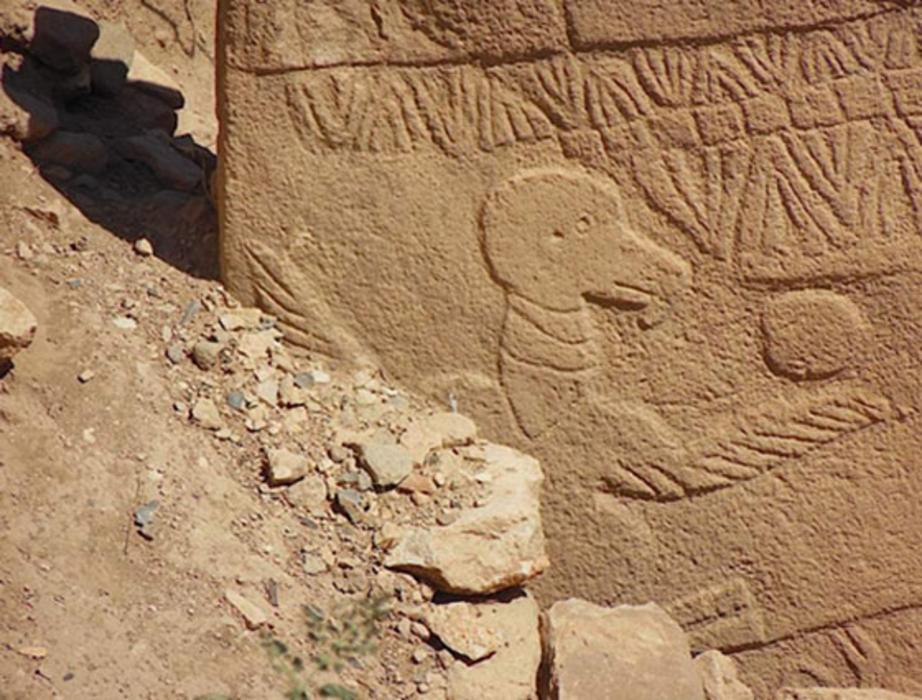
Graham Hancock in his book Magicians of the Gods (2015) writes that the scorpion on Göbekli Tepe's Pillar 43, standing in the north-northwestern section of Enclosure D's ringwall, signifies the constellation of Scorpius.(1) Having stated this, he goes on to demonstrate that the funny-looking vulture located immediately above it (see fig. 1) is the neighboring constellation of Sagittarius, a theory proposed originally by American researcher Paul Burley.(2)
As both Scorpius and Sagittarius are located on the ecliptic, the sun's path as it crosses the sky in the course of a year, Hancock, again following Burley's lead, argues that the relief of a ball-like object, shown in the form of a filled circle, positioned immediately above the vulture's right wing, is the sun in Sagittarius. During the current precessional cycle the sun is seen to rise in concert with Sagittarius at the time of the winter solstice only between the years 1960 and 2040.(3)
In this knowledge Hancock asks whether the carved imagery seen on the Vulture Stone might not be a coded message conveyed across time by the Göbekli builders of 11,500 years ago. Could it be a warning to humanity telling us that during this 80-year window the comet responsible for a terrifying impact event at the commencement of the Younger Dryas event ca. 10,800 BC might once again threaten the world? This is a daring, bold and somewhat disturbing proposition that once made, is unlikely to be forgotten. But is it right? Is it even appropriate to interpret the carved imagery of Göbekli Tepe's Vulture Stone in this way?
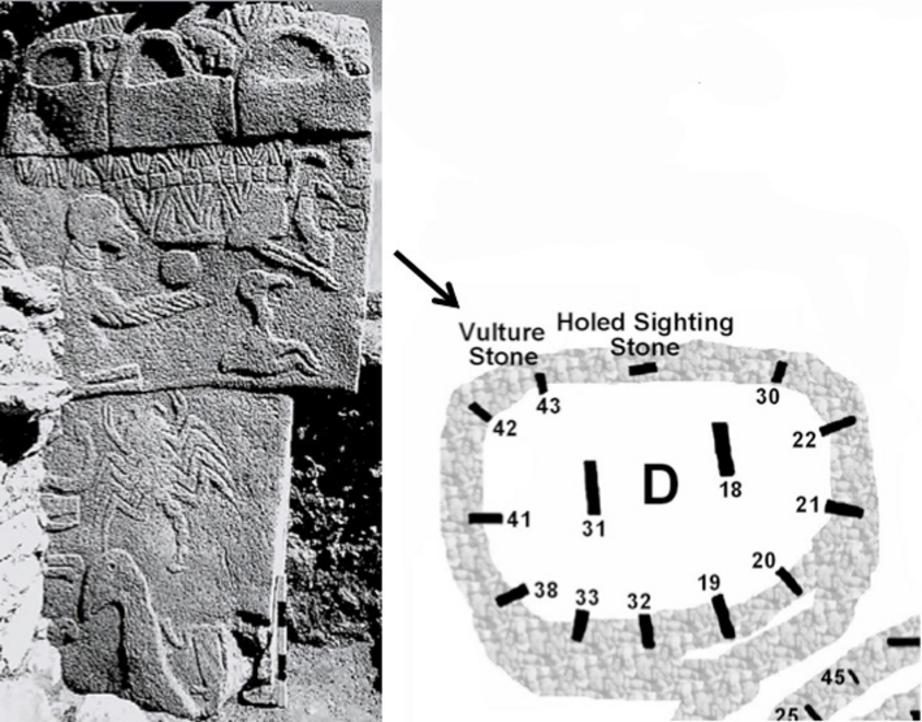
Figure 1. Pillar 43 in Göbekli Tepe's Enclosure D showing its position in the structure's perimeter wall.
Comet Impact
That the Göbekli builders built these extraordinary stone installations on a mountaintop across a period of 1,500 years with the primary purpose of counteracting the baleful influence of comets is one of the principal themes of my book Göbekli Tepe: Genesis of the Gods (2014). Here I state that even at the end of the Younger Dryas event, ca. 9600 BC, the Upper Palaeolithic populations of the Northern Hemisphere remained in absolute fear following a global cataclysm caused by a comet impact that devastated large parts of the North American and Eurasian continents at the beginning of the Younger Dryas, ca. 10,800 BC.(4) Hancock ably continues this theme in Magicians of the Gods, bringing together the most recent scientific evidence showing that this terrible catastrophe did indeed take place.
What is more, Hancock is almost certainly right in asserting that the scorpion seen on Göbekli Tepe's Pillar 43 is arguably the earliest known pictorial representation of the Scorpius constellation, something I argue also in Göbekli Tepe: Genesis of the Gods (2014) after the work of Juan Antonio Belmonte.(5) Yet going on to identify the stone pillar's carved relief of a vulture with the constellation of Sagittarius is, however, thwart with problems.
From earliest times across the Near East the vulture has been identified with just three constellations: Cygnus, the celestial bird of Hellenic tradition; Lyra, the celestial lyre of Orpheus, known also as the Falling Vulture; and Aquila, the celestial eagle called also the Flying Vulture. All three constellations are found in the same area of sky, their brightest stars - Deneb, Vega and Altair respectively - being known collectively as the Summer Triangle (see fig. 2).
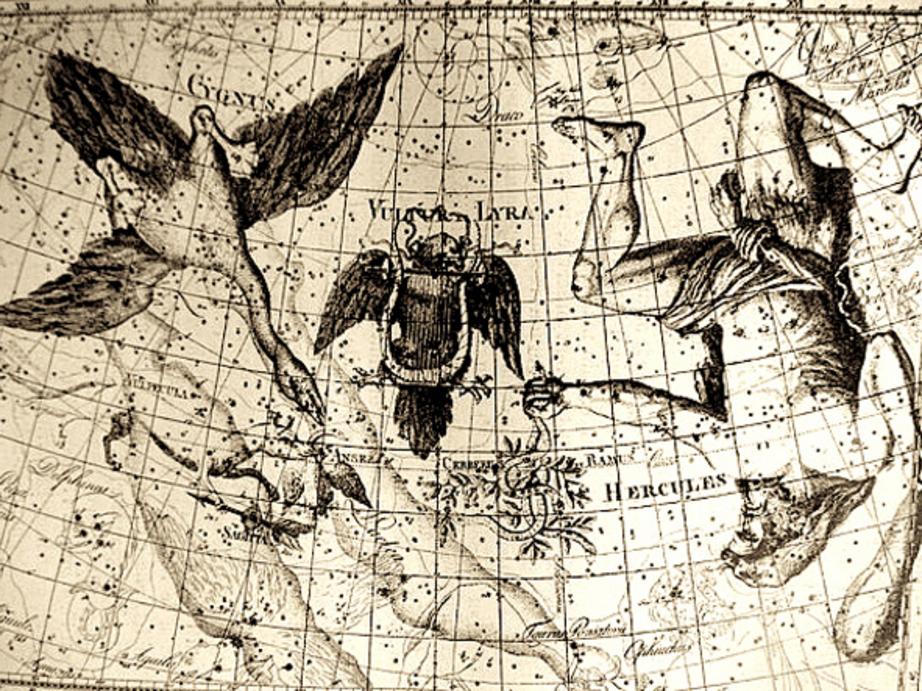
Fig. 2. Star chart showing Cygnus as a swan, Lyra as both a vulture and lyre, and Hercules upside down to the right. Aquila lies just beyond the illustration's bottom left-hand corner.
The Stymphalian birds
In Greek Hellenistic mythology these three constellations were equated with, among other things, the three Stymphalian birds that were sent against Hercules in his Sixth Labour.(6) It is an association confirmed in the knowledge that all three asterisms are located in the vicinity of the constellation of Hercules. In Mesopotamian star-lore three similar birds attack the god Marduk, and these too were personified in the night sky as the constellations of Cygnus, Lyra and Aquila.(7) In the knowledge that the Greeks identified Marduk with Hercules, it becomes clear that the myth of the Stymphalian birds originated in Mesopotamia, where all three constellations were identified as winged creatures as early as the third millennium BC.(8)
The Stymphalian birds, collectively known as the Stymphalides or Harpies, are said to have been winged monsters with "the faces of women, the bodies of vultures, and claws upon their hands."(9) The fact that they were thought to be monstrous vultures confirms their link with the constellations in question, which are all identified as vultures in Greek Hellenic star-lore - Vultur cadens ("the falling vulture") in the case of Cygnus and Lyra, and Vultur volans ("the flying vulture") in the case of Aquila.(10)
So if the vulture on Pillar 43 does represent one of the Stymphalian birds (and, interestingly, there are in fact six birds of various species and sizes carved on the stone), then most likely it is Cygnus. Not only did the twin central pillars in Enclosure D (and also those in Enclosures B, C, E & H) accurately target the setting of Deneb, Cygnus's brightest star, but we also know that its porthole stone, which stands just a few meters to the west of the Vulture Stone, was positioned so that this astronomical spectacle could be witnessed each night on the local skyline. In other words, the imagery on the Vulture Stone was in some way related to the astral purpose behind the axial orientation of the installation in which it stood. In addition to this the funny-looking vulture on Pillar 43 almost perfectly matches the outline of the main stars of Cygnus during the suspected timeframe of construction of Enclosure D (see fig. 3).
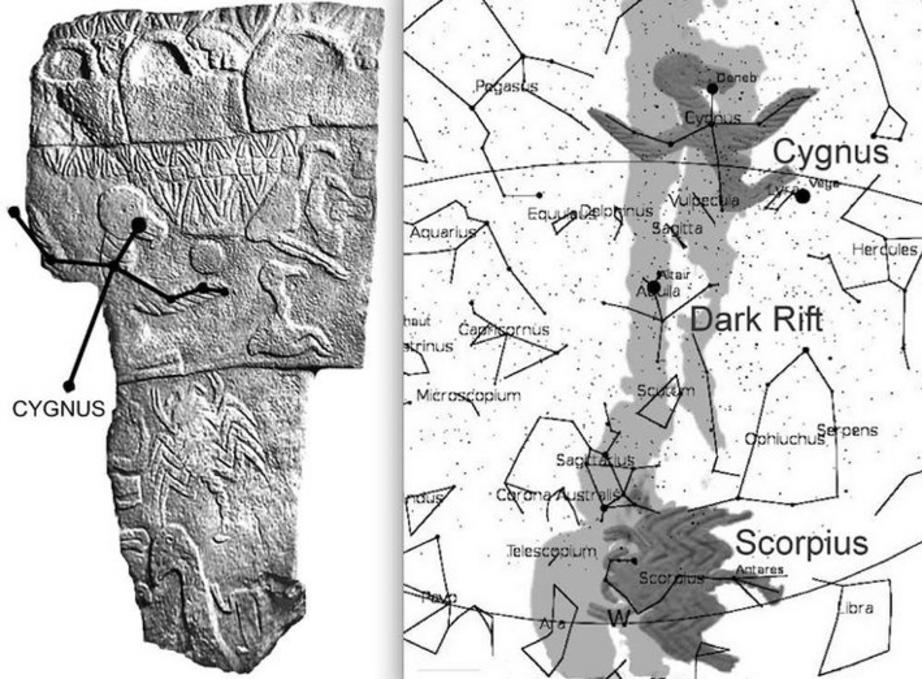
Figure 3. Left, Göbekli Tepe's Pillar 43 with Cygnus overlaid and, right, star map showing Scorpius overlaid with Pillar 43's scorpion and Cygnus overlaid with the stone vulture (pic credits: Rodney Hale).
Cygnus in Armenia
One additional piece of information linking Cygnus with the symbol of a vulture at Göbekli Tepe comes from Armenia, which borders Anatolia to the northeast. In the past, the influence of Armenia and its ruling dynasty extended as far south as Edessa, modern-day Sanliurfam, juat eight miles (13 kilometres) away from Göbekli Tepe. Indeed, many Armenians still inhabited the Sanliurfa region until the horrific atrocities of the Armenian Genocide of 1917. It is thus significant that in Armenian star lore the constellation of Cygnus is known as Angegh, a word meaning "vulture."(11) Of direct relevance here is the fact that an Armenian village named Angeghakot close to the megalithic complex of Karahunj is thought to reflect the importance of the Cygnus constellation.(12) Karahunj is made up of hundreds of standing stones that together create the likeness of the Cygnus constellation in its guise as a bird,(13) while the circular aperture in one prominently placed stone is said to target the transit of the Cygnus star Deneb as it crosses the meridian.(14) Karahunj as a whole is attributed to the Bronze Age, ca. 2500 BC, although the alignment toward Deneb argues for a much earlier date of construction, perhaps in the region of ca. 5500-5000 BC.(15)
Since angegh in the Armenian language can also means "angel," Cygnus is seen in Armenia as a heavenly angel, as well as the celestial home of the angels.(16) Yet prior to the rise of Christianity Cygnus in Armenia was quite simply a vulture, just as it was on the Euphrates during the formative years of the Mesopotamian civilizations that emerged in Lower Iraq from around 3000 BCE onward.
Paranatellons of Sagittarius
Nowhere on the Euphrates is Sagittarius identified as a vulture. Having said this all three Stymphalian birds-Cygnus, Lyra and Aquila - are classified as paranatellons of Sagittarius. A paranatellon is a constelletion that is seen to rise at the same time as one of the twelve zodiacal constellations, which in the case of Cygnus, Lyra and Aquila during the time frame in question was Sagittarius. Thus all three celestial birds came under the rule of Sagittarius. It was for this reason that the Mesopotamian form of Sagittarius, Pabilsag, a composite creature usually depicted with a horse's body, the tail of a scorpion, the wings of a bird and the head and torso of a male human figure holding a bow and arrow, is occasionally shown with birdlike feet.(17)
If the vulture on Pillar 43 does indeed represent one of these three celestial birds (and, interestingly, there are in all six birds of various species and sizes found among its carved relief), then it is likely Cygnus. Not only do the twin central pillars in Enclosure D (and also those in Enclosures B, C & E) accurately target the setting of Deneb, Cygnus's brightest star, in the epoch of its construction (these alignments have been confirmed by Italian archaeoastronomers Alessandro De Lorenzis and Vincenzo Orofino(18)) but its holed stone is oriented in order that this spectacle could have been witnessed on the local horizon (the example in Enclosure C almost certainly functioned in a similar manner).
Aside from this is the fact that the shape of the funny-winged vulture on Pillar 43 almost perfectly reflects the outline of the main stars of Cygnus in 9600 BC (see fig. 3), the suspected date of construction of Enclosure D based on radiometric dating. The vulture does not mimic the pattern created by the stars of Sagittarius, nor does it sit well with the scorpion located directly beneath the vulture on the carved panel, which we can assume to be the constellation of Scorpius.
Journey of the Soul
Pillar 43 most likely depicts the death journey of the soul of the deceased, or indeed that of the shaman. This would be the removal of a soul from its physical environment, represented by the headless figure with an erection at the base of the stone - via Scorpius, signified by the scorpion, to its final destination among the stars. This destination, arguably the entrance to the "upper world" or sky-world of Eurasian shamanic tradition, appears to have been located in the vicinity of Cygnus, represented on the pillar by the main vulture, where the soul of the individual is shown as the ball above its left wing.
The carved image of a ball-like head or filled circle is recognized in the prehistoric rock art of southeast Anatolia as being a symbol of the soul.(19) This was because the seat of the soul was always considered to reside in the head or skull. It was for this reason that, during the early Neolithic age, skulls were removed from bodies and used afterwards for oracular purposes, something thought to have occurred at Jericho (Tell es-Sultan) in Palestine. Here a number of perfectly preserved decorated skulls, dating to ca. 7000 BC, have been found that were most likely used for psychic communication with their former owners (see fig. 4).
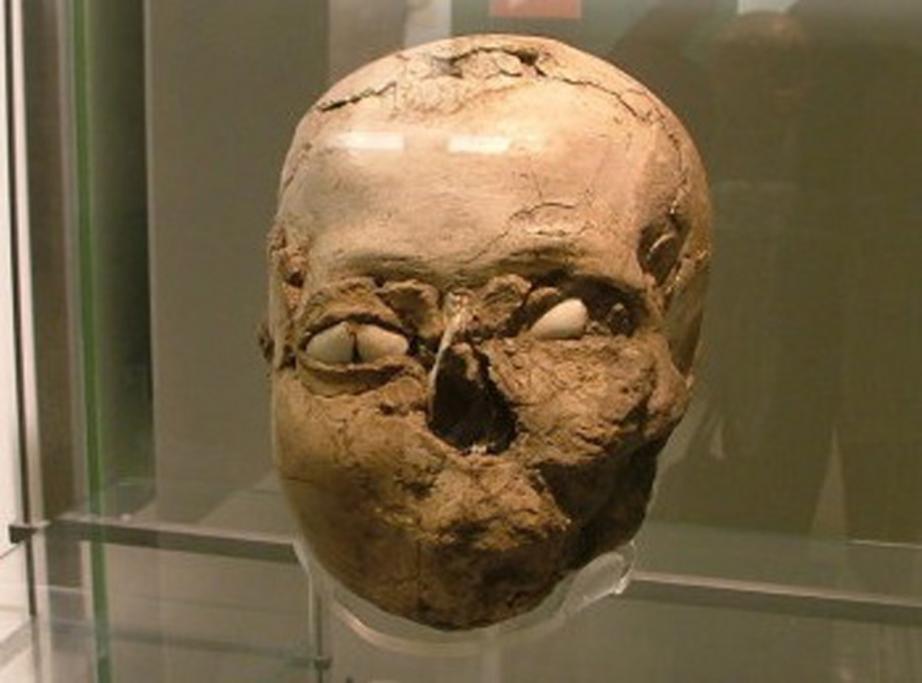
Figure 4. Decorated skull found at Jericho, Palestine, dating to ca. 7000 BC (Pic credit: Wiki Commons Agreement).
I demonstrate all this elsewhere,(20) and recently similar ideas have been voiced by Müslüm Ercan, director of Sanliurfa Museum, who is head of excavations at Göbekli Tepe on behalf of the museum. In an article titled "Signs of world's first pictograph found in Göbeklitepe," published in Turkey's Hurriyet Daily News on July 15, 2015, he proposed that: "The scene on the obelisk unearthed in Göbeklitepe [Enclosure D's Pillar 43] could be construed as the first pictograph because it depicts an event thematically. It depicts a human head [the filled circle] in the wing of a vulture and a headless human body under the stela.(21)
"There are various figures like cranes and scorpions around this figure. This is the portrayal of a moment; it could be the first example of [a] pictograph. They are not random figures."
Ercan goes on to link the vulture imagery on Göbekli Tepe's Pillar 43 with the act of disposing of the dead through the practice of excarnation, along with its allied association with the transmigration of the soul: "There were no graves 12,000 years ago. The dead bodies were left outdoors and raptors [that is, vultures] ate them. In this way, people believed the soul goes to the sky." This, he said, was called "burial in the sky," i.e. sky burial, and is depicted in the carved art at Göbekli Tepe, and also at the 9,000-year-old Neolithic city of Çatalhöyük in southern-central Anatolia. Here, shown in one particular painted fresco, are two vultures at the top of a wooden excarnation tower in the act of feasting on a human corpse, which as at Göbekli Tepe is shown as a headless figure (see fig. 5). Yet next to this scene are two more vultures on another excarnation tower that appear to be taking under their wings a ball-like head, this time with a mouth and two eyes. What we are almost certainly seeing here are the birds accepting into their care the soul of the deceased person in preparation for its journey to the next world. Other frescoes at Çatalhöyük show vultures with anthropomorphic features, suggesting they are shamans in the guise of vultures caught in the midst of ecstatic trance.
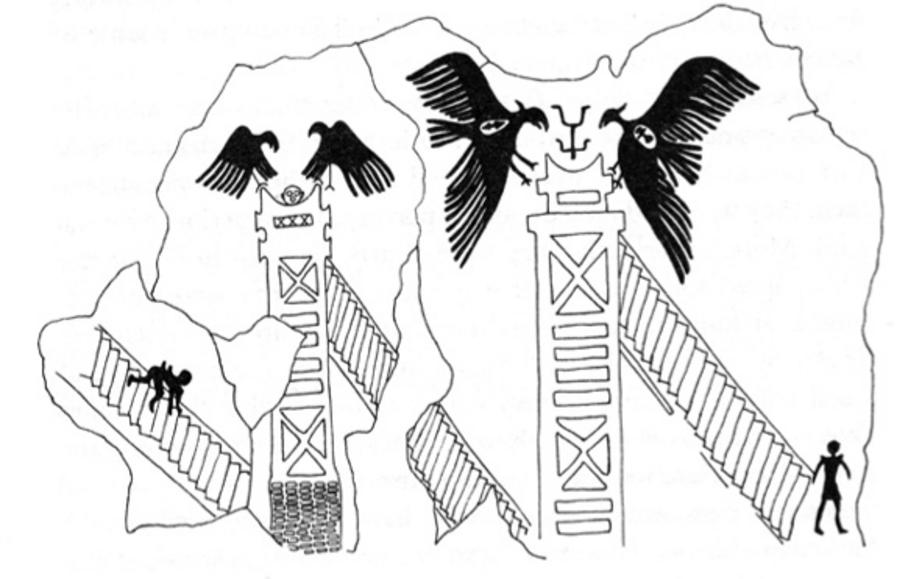
Figure 5. Frescoe from Çatalhöyük in southern-central Anatolia showing vultures devouring a corpse on the right and taking a soul into their cave on the left (pic credit: Andrew Collins).
Very likely the ball above the left wing of the vulture on Göbekli Tepe's Pillar 43 is the soul of either a deceased person, or that of a shaman, now under the protective care of the vulture who is acting in the capacity of psychopomp, a Greek word meaning "soul carrier," or "soul accompanier." Thus the visual evidence presented by the Vulture Stone allows for a comparative and consistent interpretation of its carved relief. With this in mind, it seems more plausible to conclude, as archaeologist Müslüm Ercan has done, that the overall theme being presented by the pillar's pictorial art is one of the soul's cosmic journey. At Göbekli Tepe this would have been achieved by the soul exiting this world and entering the next via the north-northwesterly placed porthole stones aligned toward the Cygnus star Deneb. It is thus no coincidence that Enclosure D's Pillar 43 is located immediately to the west of its porthole hole (see fig. 1), suggesting that the former is to be seen as a signboard marking the way to the land of the dead.
Although this explanation makes sense it is infinitely more tempting to conclude that the Vulture Stone really is a warning of impending doom conveyed across time by the Göbekli builders. This is unfortunate, as despite all the evidence to the contrary, this will persuade researchers to identify Pillar 43's funny-shaped vulture as the constellation of Sagittarius well into the future.
Top Image: Göbekli Tepe's Pillar 43, a.k.a. The Vulture Stone (pic credit: Andrew Collins).
For full references please use source link below.
